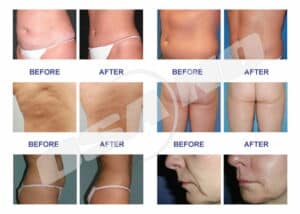
Are you struggling with excess abdominal fat and looking for effective strategies to slim down your waistline?
In this article, we’ll explore proven ways to lose belly fat fast, including:
- Popular fat removal procedures
- Eating a balanced diet focused on whole foods and protein
- Engaging in regular aerobic exercise and physical activity
- Reducing stress and getting enough quality sleep
We’ll also debunk some common myths about belly fat loss and provide practical tips to help you stay motivated on your journey to a healthier, leaner body. Whether you’re just starting out or looking to break through a weight loss plateau, these strategies can help you target stubborn belly fat and achieve your goals.
What is Belly Fat?
When you’re looking to lose fat or body weight, it’s important to understand the types that affect your health and the factors that contribute to its accumulation.
What are the Different Types of Belly Fat?

Based on the provided search results, there are two main types of belly fat:
- Subcutaneous Fat
This is the soft fat located just beneath the skin that you can pinch with your fingers. It is distributed throughout the body, but tends to accumulate around the hips, thighs, buttocks and abdomen.
Some key points about subcutaneous fat:
- It acts as a source of energy, helps regulate body temperature, and provides padding and protection for underlying tissues.
- While excess amounts can contribute to obesity, it is generally considered less harmful to health than visceral fat.
- It can be reduced through lifestyle changes like diet and exercise.
2. Visceral Fat
Also known as intra-abdominal fat, visceral fat is stored deep within the abdominal cavity, surrounding the internal organs like the liver, pancreas and intestines.
Key characteristics of visceral fat include:
- It is located beneath the abdominal muscles and is not visible from the outside. Only 10-20% of total body fat is visceral fat.
- Visceral fat is metabolically active, releasing substances that can contribute to inflammation, insulin resistance, and other health problems.
- It is more strongly associated with an increased risk of serious health issues like heart disease, type 2 diabetes, and certain cancers compared to subcutaneous fat.
- Visceral fat tends to be more prevalent in men and people of European descent and increases with age, especially after menopause in women.
3. Some other specific types of belly fat mentioned include:
- Upper belly fat caused by diet high in sugar
- Lower belly fat potentially caused by stress
- Fat with a protruding, hard belly possibly due to excess alcohol consumption
Factors Contributing to Belly Fat
- Genetics: Your genes can influence how and where your body stores fat.
- Hormones: Fluctuations, particularly in cortisol and insulin, can lead to increased fat storage around your belly.
- Diet: High intakes of trans fats and sugary foods can lead to more belly fat, while a balanced diet helps regulate your blood sugar levels.
- Exercise: Regular activity, including strength training and high-intensity interval workouts, can help reduce both visceral and subcutaneous belly fat.
- Stress: Chronic stress can lead to an increase in cortisol, which might encourage your body to store more visceral fat.
- Alcohol and Smoking: Excessive drinking and smoking are linked to an increase in belly fat.
- Sleep: Poor sleep patterns can disrupt hormonal balance, leading to weight gain around the midsection.
10 Procedures To Help Fat Removal

Vanquish
Vanquish is a radiofrequency treatment that uses heat to destroy fat cells without touching the skin. It targets larger body areas compared to other non-invasive options. Vanquish requires 4-10 sessions spaced one week apart, with permanent results visible two months after the final treatment.
Liposonix and Ultrashape
These are ultrasound-based fat removal procedures that use ultrasound energy to liquefy fat before removing it with a thin cannula. They are less aggressive than traditional liposuction. Like other non-invasive methods, Liposonix and Ultrashape are meant for reducing fat deposits resistant to diet and exercise, not for significant weight loss.
SmartLipo
SmartLipo is a laser-assisted liposuction technique that uses laser energy to melt fat before removal, making it easier to suction out with a cannula. It also provides some skin tightening benefits. While still surgical, SmartLipo is less invasive than traditional liposuction.
ThermaLipo
ThermaLipo combines laser liposuction with radiofrequency to reduce fat and tighten skin. A local anesthetic is used. It works well for the hips, waist, abdomen, thighs and face. Results are visible within a few days, with full effects seen in a few weeks.
Emsculpt and Emsculpt NEO
These treatments use high-intensity focused electromagnetic energy to stimulate muscle contractions, which builds muscle and burns fat. Emsculpt NEO also incorporates radiofrequency to melt fat while toning muscle. It is the only non-invasive option that addresses fat, muscle and skin at the same time.
CoolSculpting (Cryolipolysis)
CoolSculpting uses controlled cooling to freeze and destroy fat cells in targeted areas. The fat cells crystallize, die, and are naturally eliminated by the body over time. CoolSculpting is FDA-cleared and can treat areas like the abdomen, flanks, thighs, chin, back, and arms. Patients may need 1-3 treatments to achieve optimal results, which develop over several weeks to months.
SculpSure, Zerona
Laser fat reduction procedures like SculpSure and Zerona use laser energy to heat and destroy fat cells. Zerona is a low-level laser treatment (LLLT) that creates temporary pores in fat cells, causing them to release their contents and shrink. SculpSure uses a higher temperature to permanently destroy fat cells. These treatments are best for small, localized fat deposits and may require multiple sessions for noticeable results.
Kybella
Kybella is an injectable treatment that uses a synthetic form of deoxycholic acid to dissolve fat cells. It is FDA-approved specifically for treating submental fat (double chin). Kybella requires a series of injections spaced 6-8 weeks apart for best results.
Nutritional Strategies for Reducing Belly Fat

To effectively reduce belly fat, it’s crucial to modify your diet with precision, focusing on calorie balance and nutrient quality to see meaningful changes.
Understanding the Role of Calories
Calories are the basic units of energy that your body uses for all its functions. To lose belly fat, you need to consume fewer calories than your body burns throughout the day. This creates what’s known as a calorie deficit, leading to fat loss. Aim for a sustainable deficit, typically between 500-1000 calories per day, which could equate to about 1-2 pounds of weight loss per week.
Importance of Macronutrients
Macronutrients are the nutrients you need in larger amounts, like protein, carbohydrates, and fats:
- Protein: Essential for muscle repair and growth, protein also helps keep you full. Include sources like lean meats, fish, beans, and legumes in your meals.
- Carbohydrates: Focus on complex carbs found in whole grains, vegetables, and fruits. They take longer to digest, keeping you fuller and providing energy.
- Fats: Not all fats are bad. Include healthy fats from nuts, seeds, and avocados, while minimizing intake of trans fats and saturated fats.
The Benefits of Fiber-Rich Foods
Dietary fiber, particularly from fiber-rich foods like vegetables, fruits, legumes, and whole grains, is crucial for weight management. Fiber aids digestion, helps regulate blood sugar levels, and reduces cravings by making you feel full longer. Aim to consume at least 25-30 grams of fiber daily. This will also help in staying hydrated, so don’t forget to drink plenty of water to facilitate the fiber’s benefits. Avoiding processed foods, sugar, and added sugars that are low in fiber but high in calories can further improve your belly fat loss efforts.
Exercise for Targeting Belly Fat
To effectively lose belly fat, you should focus on exercises that not only burn fat but also build muscle. Incorporating a mix of cardiovascular exercises, strength training, and high-intensity interval training can create a well-rounded routine that targets belly fat.
Cardiovascular Exercises to Burn Fat
Cardiovascular exercises play a crucial role in creating a calorie deficit, which is vital for fat loss. Aerobic exercise such as:
- Running: Can burn significant calories; aim for sessions that last at least 30 minutes.
- Walking: A low-impact alternative suited for all fitness levels; brisk walking is particularly effective.
Carrying out cardio consistently helps decrease visceral fat and can be a stepping stone to more intense workouts.
Strength Training to Build Muscle
Building muscle mass is key to increasing your metabolic rate and burning more calories even at rest. Incorporate resistance training such as:
- Dumbbell exercises: to target and define your abs.
- Barbell movements: to engage multiple muscle groups and improve overall strength.
Strong muscles support a healthy metabolism, which can contribute to greater fat loss over time.
High-Intensity Interval Training (HIIT)
HIIT involves short bursts of intense exercise followed by recovery periods. This type of training is highly effective due to the “afterburn effect,” where your body continues to burn calories post-workout. Include interval training that mixes:
- Sprinting: for an all-out effort that spikes your heart rate.
- Bodyweight exercises: like jump squats or burpees to keep the intensity high.
HIIT sessions can be brief (20-30 minutes) yet powerful, offering a time-efficient method for reducing belly fat.
Lifestyle Adjustments for Sustainable Weight Loss
In shedding belly fat, it’s not just about the food you eat or the exercise you do; lifestyle factors like sleep, stress management, and hydration play crucial roles. Let’s explore how you can leverage these for weight management.
The Impact of Sleep on Weight Loss
Research shows good sleep is foundational for weight loss. Poor sleep can lead to weight gain, as it’s linked to an increase in the hormone ghrelin, which triggers hunger. Aim for 7-9 hours of quality sleep per night to help keep your hunger hormones in check. If you suffer from sleep apnea, addressing this condition can significantly impact your ability to lose weight and reduce belly fat.
Stress Management Techniques
Stress can sabotage weight loss efforts, leading to unhealthy eating habits and increased belly fat. Utilizing techniques such as deep breathing, meditation, or yoga can help manage stress levels. Consistency in these practices leads to better stress management and supports healthy weight loss.
The Importance of Hydration
Staying hydrated is key to weight management. Often, feelings of hunger can be confused with dehydration. Before reaching for a snack, try drinking water to ensure that it’s not thirst you’re experiencing. Also, minimizing alcohol consumption can prevent unnecessary calorie intake and support a healthy weight.
Frequently Asked Questions
Can you suggest a diet plan focused on losing belly fat within a month?
A monthly diet plan for belly fat loss should include a calorie deficit with nutritious meals spread throughout the day. Aim for balanced macros with an emphasis on protein and fiber. Avoid crash diets; instead, choose sustainable healthy eating habits.






